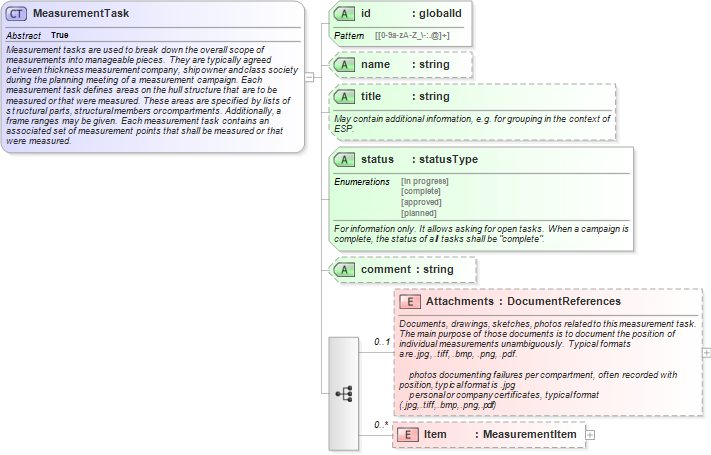<xs:complexType name="MeasurementTask" abstract="true" final="">
<xs:annotation>
<xs:documentation xml:lang="en">Measurement tasks are used to break down the overall scope of measurements into manageable pieces. They are typically agreed between thickness measurement company, ship owner and class society during the planning meeting of a measurement campaign. Each measurement task defines areas on the hull structure that are to be measured or that were measured. These areas are specified by lists of structural parts, structural members or compartments. Additionally, a frame ranges may be given. Each measurement task contains an associated set of measurement points that shall be measured or that were measured.</xs:documentation>
</xs:annotation>
<xs:sequence>
<xs:element name="Attachments" type="DocumentReferences" minOccurs="0">
<xs:annotation>
<xs:documentation xml:lang="en">Documents, drawings, sketches, photos related to this measurement task. The main purpose of those documents is to document the position of individual measurements unambiguously. Typical formats
are .jpg, .tiff, .bmp, .png, .pdf.
<UL><li>photos documenting failures per compartment, often recorded with position, typical format is .jpg</li>
<li>personal or company certificates, typical format (.jpg,.tiff,.bmp,.png,.pdf)</li>
</UL>
</xs:documentation>
</xs:annotation>
</xs:element>
<xs:element name="Item" type="MeasurementItem" minOccurs="0" maxOccurs="unbounded" />
</xs:sequence>
<xs:attribute name="id" type="globalId" use="required" />
<xs:attribute name="name" type="xs:string" />
<xs:attribute name="title" type="xs:string">
<xs:annotation>
<xs:documentation xml:lang="en">May contain additional information, e.g. for grouping in the context of ESP.</xs:documentation>
</xs:annotation>
</xs:attribute>
<xs:attribute name="status" type="statusType" use="required">
<xs:annotation>
<xs:documentation xml:lang="en">For information only. It allows asking for open tasks. When a campaign is complete, the status of all tasks shall be "complete".</xs:documentation>
</xs:annotation>
</xs:attribute>
<xs:attribute name="comment" type="xs:string" />
</xs:complexType>
|

